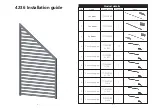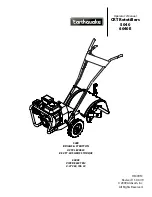
o
You press
AUTO
or use the slider to continue with the next valid
scene after the
End
scene.
5.
When the last valid scene is reached or when scene 63 is reached, the next
press of
AUTO
or use of the slider takes you to scene 1, or to the first valid
scene.
External Control
External control (indicated by a dot in the left of the display) means that you use a
10/12V analog controller to send latching or flashing signals to Power Cue Store.
These signals are discussed in more detail in “Remote Input Device”.
Latching the external control line stops output from the Power Cue Store and causes
to be shown in the display.
Flash
STEP
to access the first valid scene, and then do any of the following:
o
Flash
STEP
to advance to the next valid scene or the selected scene shown
in the display.
Hold times are ignored but Fade times are processed.
o
Latching or flashing
START
begins an automatic sequence that processes
both fade and hold times.
o
Latching
STOP
ends a sequence after processing the current fade or hold
signal.
Power Cue Store then awaits a
STEP
or
START
signal.
o
Latching
PAUSE
suspends a sequence without completing the current
operation.
When
PAUSE
is released, the sequence resumes from the pause point unless
a new scene has been selected. In this latter case, all of the relevant Fade or
Hold times are processed.
o
Flashing
TOP
takes the Power Cue Store back to the blackout state, and
-
appears in the display.
o
If
START
is latched on, the sequence will begin to run.
o
If
TOP
is latched on, Power Cue Store goes back to the blackout state, and
—-
appears in the display. Power Cue Store remains in blackout until
TOP
is released.
Note the following:
o
Attempting to step beyond scene 63 takes you back to the blackout state and
the Power Cue Store waits for a new STEP or START signal.
If START was latched on already, the sequence loops automatically back to
the first valid scene.
o
Deleted, empty scenes are ignored.
o
A start-of-chase scene (SoC) causes a chase to start running according to the
pre-programmed fade and hold times.
o
When an end-of-chase scene (End) scene is encountered, the chase will loop
and continue to run.
Page
12
Power Cue Store
TM
User Manual





































